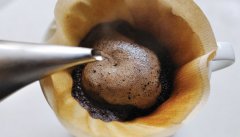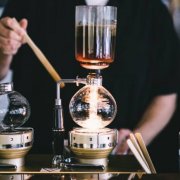Effect of optimum brewing water temperature of Italian coffee machine on the taste and extraction of espresso

Professional coffee knowledge exchange more coffee bean information please follow the coffee workshop (Wechat official account cafe_style)
Relationship between water temperature of hand-brewed coffee and extraction tools and freshness of coffee beans
As long as we choose the right coffee machine, we can adjust the water temperature at will, but people's understanding of the water temperature is different. Many coffee shops do not use water temperature as one of the indicators to adjust coffee brewing parameters, but there are also many coffee shops use water temperature as the only tool to control the extraction rate and solve the temperature changes of boilers and bean grinders.
In order to enable you to understand the water temperature more clearly and thoroughly, I have conducted a series of tests and will share the test results with you in this article.
The "temperature of water" in the eyes of others

Many people believe that under the premise of using standard brewing formula and stable brewing technique, the higher the water temperature is, the higher the extraction rate is; the lower the water temperature is, the lower the extraction rate of soluble substances is. From a taste point of view, the higher the water temperature, the fuller the taste and the sweeter the coffee (bitter and astringent taste will increase in most cases); the lower the water temperature, the lower the bitterness, the thinner the taste and the lower the sweetness (in most cases, the sour taste is heavier and the taste is purer).
Baristas who know the temperature of the water may give the following advice:
1. The lower the water temperature, the higher the acidity; the higher the water temperature, the lower the acidity.
2. With the increase of the temperature of the bean grinder, the solubility of the coffee powder will be improved, and the extraction rate will also increase, so lowering the water temperature can avoid the effect of the temperature change of the bean grinder on the taste and quality of coffee.
3. The best way to adjust the extraction rate is not to change the grinding degree, but to change the water temperature.
4. If the extraction is too slow, increasing the water temperature can improve the extraction rate of coffee.
5. High water temperature can make up for the deficiency of inadequate roasted coffee, while low water temperature can overcome the problem of high solubility of over-roasted coffee.
The above suggestions have been widely adopted and used in many commercial cafes. These statements are half-false and half-true, and some of them are true, but without data support, we can never come to a correct conclusion. Today, I will strictly monitor the thickness, density and water temperature of pressed powder with professional instruments, and then answer a very simple question: how on earth will water temperature affect the extraction rate and taste?
Effect of water temperature on extraction rate
In order to test the effect of water temperature on the extraction rate, I carried out the following tests:
Grind a large amount of coffee powder at one time to reduce the coffee powder to room temperature and make 44 cups of espresso with 22g powder.
Coffee is made with a standard formula: 22g coffee powder, 46-48g coffee, brewing time of 29 seconds. Stockfleth method is used to remove powder. A single tap on pressed powder is followed by compaction of pressed powder (very tight).
The production uses a single head coffee machine and a single outlet handle.
Set the water temperature to 92 ℃, 94 ℃, 96 ℃ and 98 ℃, and make 10 cups of coffee at each temperature.
The brewing time and the total weight of coffee are recorded during each production.
Each cup of coffee is sampled and sealed with an eyedropper to prevent the sample from evaporating.
Each sample is filtered and TDS (soluble matter ratio) is calculated.
The extraction rate of each sample was calculated and recorded.
Sample and taste at the same time.
data
I classified the data of each temperature sample and removed two highest values and one lowest value to control the sample size and avoid data deviation caused by operational errors.
The sample data corresponding to each temperature are recorded in Table 1-4. Figure 1 summarizes the data in tables 1-4.
Results Chart 1: trend chart of average extraction rate of espresso at different water temperatures

The trend shown in the above figure is very obvious, the extraction rate of espresso brewed at lower water temperature is lower, while the extraction rate of espresso brewed at higher water temperature is higher. If the sample size is larger, it is believed that this trend will be more obvious. Surprisingly, only 6 ℃ of water temperature difference, the corresponding difference in extraction rate is so small! The difference between 92 ℃ and 98 ℃ is only about 0.5%. What is more interesting is that although there is little difference in the extraction rate, the taste of coffee varies greatly.
Effect of water temperature on taste
Although there is little difference in extraction rate, there is a significant difference in coffee taste under the four water temperatures. My staff and I conducted a blind product test, and the results were as we expected:
The coffee with the lowest water temperature has the thinnest taste, the lowest sweetness, the lightest bitterness, but the highest acidity.
The coffee with the highest water temperature has the thickest taste, higher sweetness and the thickest bitterness, but always has acidity and slightly rough taste.
Coffee with moderate water temperature has a balanced taste, the highest sweetness, the most balanced acidity, light bitterness and moderate taste.
Is this change in taste due to the difference in extraction rate or the difference in the composition and structure of soluble substances in coffee? Or both? Personally, I think both of them will affect the taste of coffee. The change of coffee taste with water temperature is consistent with the conclusion in Coffee Brewing Handbook (author: Ted Lingle, SCAA of American Fine Coffee Association). The following is a chart I have summarized and analyzed from the data in the book, which shows the change of water temperature on the taste of coffee (74 ℃, 94 ℃ and 100 ℃ respectively):

From the figure, we can see the following trend: the total amount of citric acid (Citric acid) extracted shows a downward trend in the range of 94-100 ℃. The content of malic acid (Malic acid) in coffee was the lowest under 94 ℃. The extraction was the best at 94 ℃ (the highest amount of sucrose extraction), and the extraction amount of sucrose (Sucrose) from coffee increased sharply between 74 ℃ and 94 ℃. We can see that the water temperature has a great influence on the composition and structure of soluble substances in coffee. If this does not explain the taste change we have just felt, it is likely that the extraction rate has an effect on the taste of coffee.
Summary
We can draw two conclusions from the data:
1. Higher water temperature, higher extraction rate, higher sweetness, more bitterness, more mellow taste and lower acidity
two。 The water temperature is lower, the extraction rate is lower, the taste is thinner, the sweetness is lower, the bitterness is lighter and the sour taste is more obvious. Although there is little difference in extraction rate, there is a significant difference in the taste of coffee.
Therefore, I think that the effect of water temperature on the structure of soluble substances in coffee is greater than that on the extraction rate, and the change of extraction of individual flavor substances is more obvious than that of the whole extraction rate.
.
Important Notice :
前街咖啡 FrontStreet Coffee has moved to new addredd:
FrontStreet Coffee Address: 315,Donghua East Road,GuangZhou
Tel:020 38364473
- Prev

How many degrees of water temperature is the appropriate temperature for brewing coffee? Different water temperatures extract different flavors.
Professional coffee knowledge exchange more coffee bean information please follow the coffee workshop (Wechat official account cafe_style) the relationship between the water temperature of hand-brewing coffee and the extraction tools and the freshness of coffee beans occasionally see people using water that has just been removed from the stove and still boiling to make coffee. When this happens, I always imagine the taste of that cup of coffee in my mind.
- Next

Siphon Coffee Brewing Tips Siphon pot best water temperature for brewing coffee
Professional coffee knowledge exchange More coffee bean information Please pay attention to coffee workshop (Weixin Official Accounts cafe_style) The relationship between hand-brewed coffee brewing water temperature and extraction tools and coffee bean freshness 1. Boil in fresh water (be sure to filter) and boil thoroughly. When the coffee powder is soaked in hot water, the temperature of the hot water needs to be around 90 degrees, and then filtered into the coffee pot will change.
Related
- Beginners will see the "Coffee pull flower" guide!
- What is the difference between ice blog purified milk and ordinary milk coffee?
- Why is the Philippines the largest producer of crops in Liberia?
- For coffee extraction, should the fine powder be retained?
- How does extracted espresso fill pressed powder? How much strength does it take to press the powder?
- How to make jasmine cold extract coffee? Is the jasmine + latte good?
- Will this little toy really make the coffee taste better? How does Lily Drip affect coffee extraction?
- Will the action of slapping the filter cup also affect coffee extraction?
- What's the difference between powder-to-water ratio and powder-to-liquid ratio?
- What is the Ethiopian local species? What does it have to do with Heirloom native species?

